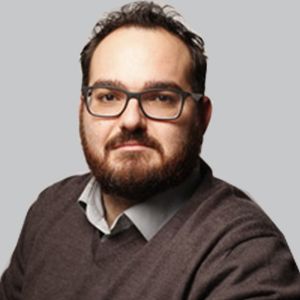Article
Manousos Klados, MSc, PhD, FIMA, FHEA, on the HOPE Project in Epilepsy
Author(s):
A new research project is underway to improve the pre-surgical evaluation of pediatrics with medical refractory epilepsy.

Manousos Klados, MSc, PhD, FIMA, FHEA
Despite the continuous development of new therapies targeting the mechanisms responsible for generating epileptic seizures, some patients still suffer from seizures and are proven medically resistant, making surgery the only remaining alternative. The portion of the brain that should be resected is defined nowadays by intracranial electroenecephalogram (iEEG), however, iEEG presents several limitations like its invasiveness and cost.
Manousos Klados, MSc, PhD, FIMA, FEMA, Aston University, the lead researcher of the HOPE Project is aiming to develop a non-invasive method to precisely localize the epileptogenic tissue. Klados and his colleagues hope to improve the current procedures for the detection of the epileptogenic tissue as for the post-surgical outcomes with a non-invasive technique, which would greatly impact the current clinical practice.
To further discuss the HOPE Project and its goals, NeurologyLive spoke with Klados.
NeurologyLive: What's the HOPE Project?
Manousos Klados, MSc, PhD, FIMA, FHEA: The main problem that we face nowadays in this kind of epilepsy that cannot be treated with drugs, especially in children, is that these children should have a surgery to remove the epileptogenic brain tissue that is responsible for the generation of epileptic seizures. In order to define which area of the brain should be removed, the common practice is an open surgery where the surgeons place implanted electrodes inside the brain and they monitor the patient for 1—2 weeks. Imagine that the patient is on a bed, awake with the implanted electrodes inside the brain for 1 or 2 weeks and imagine how difficult it is for the child—and that’s not even speaking about the expenses and the cost billing of this procedure.
HOPE consortium tries to replace this invasive procedure, with a non-invasive one. To do that, we are going to exploit some signal patterns that originate from the epileptogenic tissue. These signals are called high-frequency oscillations and they appear so in iEEG as in EEG and MEG signals. Our goal is to automatically detect them using non-invasive procedures, like EEG and MEG, and accurate localize their origin. Moreover, we would like to investigate if they can be suppressed using neurofeedback and if so, the impact of this suppression in epilepsy.
We are working in collaboration with many partners, from both academic and non-academic sector. For example, one partner (GTEC) is a world leading company in neuroengineering and brain computer interfaces who is working with us at Aston University in order to develop EEG sensors that have an increased signal to noise ratio in higher frequencies, so as to reduce the noise in high frequencies making it more easily to detect these higher frequency oscillations. Another partner (YorkInstruments), a company here from the UK, works in a similar concept developing MEG SQUIDs in order to increase the signal to noise ratio in higher frequencies. Closing with the hardware partners, a company from Greece (INBIT) is responsible for all the legal regulation that medical devices should follow in order to be available on the market. Further to our hardware partners, we are collaborating with a company (Brainsigns) from Italy, specializing in deep learning algorithms in order to mathematically detect this kind of signals in close collaboration with Aston University, while another company from Cyprus (AAISCS) works on the localization of these signals, because the first part is to detect them on the scalp EEG/MEG and then we should localize them accurately in the brain, to see where they come from (epileptogenic tissue). We also have 2 hospitals (Birmingham Women's and Children's Hospital and Boston Children's Hospital) that provide us with neuroimaging data, as well as. A big part of the consortium is composed by 6 academic institutes, who are responsible for transferring the academic knowledge in our non-academic partners, as well as to train the future researchers in pediatric epilepsy and neuroscience. These universities are Aston University (AST), 2 universities from Greece (AUTH and TUC), another 2 from the Netherlands (VUMC and UMCU) and 1 from Italy (UNITOV). UNITOV with AUTH work also in developing the platform that is going to suppress the aforementioned high-frequency oscillations, TUC works closely with AAISCS for the localization of these signature signals, while VUMC and UMCU are supporting HOPE by providing existing data for the preliminary analyses.
Has the project started?
Some of our partners have done work in this direction and so we have some preliminary results that have demonstrated the project has solid ground to continue but we need about 4 years to allow the project to finish. We hope that we can somehow try to incorporate this into everyday clinical practice.
Is there a specific type of epilepsy you're studying?
Yes, but this can be extended to other types of epilepsy. For example, for epilepsies that can be treated with drugs, these brain indices can be used to monitor the progress of the treatment or detect seizures. I don’t know if that’s possible though because no one has investigated if this can be used as an early detection marker for epilepsy, but it seems possible.
How important is this project clinically?
If you forget the stress, all the invasive nature of these procedures and all the psychological effects it has on children and their parents and so on, there are some problems with this invasive technique where sometimes the electrodes are not properly placed inside the brain so they may not actually record and detect the area that is responsible because the signal is propagating from the epileptogenic area to where the electrode is, so there is kind of this misinterpretation. In addition, our neurofeedback platform may be used to reduce so the intensity as the frequency of the seizures.
Transcript has been edited for clarity.




